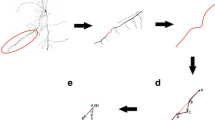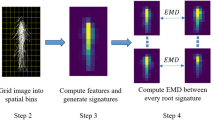Abstract
Root length density (RLD) is a key factor in crop functioning. A field method was developed to quantify RLD of sugarcane from root intersection density (RID) taking root orientations into account. RIDs were observed on three perpendicular soil planes and RLD was measured for the enclosed volume. RID and RLD of thick and fine roots were measured separately. These measurements were replicated at different ages and sites to test models describing RLD according to RID. Fine roots were nearly isotropic and thick roots had a preferential orientation, i.e. horizontal near the surface and becoming progressively vertical in deeper horizons. Relationships in thick roots were modelled according to COt: RLDt = RIDt. COt (COt: root orientation coefficient, ranged from 1.3 to 4.9 for thick roots). For fine roots (f), COf = 2. This theoretical model led to differences between measured and calculated RLD. The ratio between measured and calculated RLDf (CEf) increased from 1 to 3 with RIDf. CEf was introduced as an additional coefficient in the model: RLDf = 2. NIf. CEf. Intermediate results were obtained for all (a) roots: COa and CEa were both dependent on RIDa, therefore: RLDa = NIa. COa. CEa. The models were validated with independent datasets from Brazil and France. These allowed a more robust prediction of RLD than direct regressions between RID and RLD. They may estimate RLD from RID in soil profiles by root mapping while taking RLD spatial variability into account.






Similar content being viewed by others
Abbreviations
- CO:
-
Geometric coefficient to calculate RLD from RID
- CE:
-
Experimental coefficient to calculate RLD from RID
- DAP:
-
Days after planting
- d:
-
root diameter (mm)
- DAR:
-
Days after ratoon
- MD:
-
Methodology development (of models)
- MV:
-
Methodology validation (of models)
- RID:
-
Root intersection density (per m2)
- RLD:
-
Root length density (m m−3)
References
Bengough AG, Mackenzie CJ, Diggle AJ (1992) Relations between root length densities and root intersections with horizontal and vertical planes using root growth modelling in 3-dimensions. Plant Soil 45:245–252
Blackburn F (1984) Sugar-cane. Longman, New York, USA (ISBN:0-582-46028-X)
Böhm W (1976) In situ estimation of root length at (natural soil profiles. J Agric Camb 87:365–368
Box JE (1996) Modern methods for root investigations. In: Waisel et al (ed) Plant Roots the Hidden Half. Dekker, New York, pp 193–237
Cahn MD, Zobel RW, Bouldin DR (1989) Relationship between root elongation rate and diameter and duration of growth of lateral roots of maize. Plant Soil 119:271–279
Chen JCP, Chou CC (1993) Cane sugar Handbook. Wiley, Indianapolis (ISBN 0471530379)
Chopart JL, Siband P (1999) Development and validation of a model to describe root length density of maize from root counts on soil profiles. Plant Soil 214:61–74
Chopart JL, Siband P, Dingkhun M, Roveda G, Baquero J (2001) From single plane profiles to root length density in space. Validation of a model in the field. Root Res 10:586–567
Chopart JL, Payet N, Saint Macary H, Vauclin M (2007a) Is maize root growth affected by pig slurry application on a tropical acid soil? Plant Root 1:75–84
Chopart JL, Aure F, Le Mézo L, Mézino M, Antoir J, Vauclin M (2007b) Field tests of OSIRI, a decision making tool for irrigation of sugarcane farms in Réunion. In: USCID (ed) The role of irrigation and drainage in a sustainable future. Denver (CO), USA, pp. 423, 435
Crutzen PJ, Mosier AR, Smith KA Winiwarter W (2007) N2O release from agro-bio-fuel production global warming reduction by replacing fossil fuels. Atmos Chem Phys Discuss 7:11191-11205, www.atmos-chem-phys-discuss/7/11191/2007
Drew MC, Saker LR (1980) Assessment of a rapid method using soil cores for estimating the amount and distribution of crop roots in the field. Plant Soil 55:297–295
Evans H (1936) The root system of sugar cane II some typical root systems. Empire J Exp Agric 4:208–221
Freire WJ, Cortez LAB (2000) Vinhaça de cana-de-acucar. Agropecuaria, Campinas, p 202
Grabarnik P, Pages L, Bengough A (1998) Geometrical properties of simulated maize root systems: consequences for length density and intersection density. Plant Soil 200:157–167
Gregory PJ (1989) The role of root characteristics in moderating the effects of drought. In: Drought resistance in cereals. Proceeding of a symposium held in Cairo, Egypt, 28–30 November 1988, pp 141–150
Gregory PJ (2006) Plant roots: Growth, Activity and interactions with soils. Blackwell, Oxford, p 318
Inmam-Bamber NG, Smith DM (2005) Water relations in sugarcane and response to water deficits. Field Crops Research 92:185–202
Lang ARG, Melhuish FM (1970) Length and diameters of plant roots in non-random populations by analysis of plane surface. Biometrics 26:421–431
Loague K, Green RE (1991) Statistical and graphical methods for evaluating solute transport models: Overview and applications. J Contam Hydrol 7:51–73
Lopez-Zamora I, Newton F, Comerford NB, Barros NF (2002) Root isotropy and an evaluation of a method for measuring root distribution in soil trenches. Forest Ecology and management 166:303–310
Lynch J (1995) Root Architecture and Plant Productivity. Plant Physiol 109:7–13
Melhuish FM, Lang ARG (1968) Quantitative of root in soil. I Length and diameters of cotton roots in a clay-loam soil by analysis of surface-ground block of resin-impregrated soil. Soil Sci 106:16–22
Moore PH (1987) Anatomy and morphology. In: Heinz DJ (ed) Sugarcane improvement trough breeding. Elsevier, Amsterdam, Netherlands, pp 85–142
Nash JE, Sutcliffe JV (1970) River flow forecasting through conceptual models. J Hydrol 10:282–290
Newman EI (1966) A method of estimating the total length of roots in a sample. J App Ecol 3:139–145
Radanielson A, Dusserre J, Chopart JL, Audebert A (2007) Root model calibration to describe root length density for rainfed rice using soil profile root impacts. In: INRA (ed) Rhizosphere II International Conference. Montpellier, France, p 126
Smith DM, Inman-Bamber NG, Thorburn PJ (2005) Growth and function of the sugarcane root system. Field Crops Research 92:169–183
Tardieu F (1988) Analysis of the spatial variability of maize root density. I- Effect of wheel compaction on the spatial arrangement of roots. Plant Soil 107:259–266
Tennant D (1975) A test of a modified line intersect method of estimating root length. J Ecol 63:955–1001
van Dillewjin C (1952) Botany of sugarcane. Veenman & Zonen, Wageningen
van Noordwijk M (1987) Method for quantification of root distribution patterns and root dynamics in the field. In: International Potash Institute (ed) 20th Symposium. Bern, Switzerland, pp 247–256
Vepraskas MJ, Hoyt GD (1988) Comparison of the trench-profile and core methods for evaluating root distribution in tillage studies. Agron J 80:166–172
Wilkins SY, Yoshida T, Chen S (1993) Photosynthesis of sugarcane. Caneworld, New York
Acknowledgments
This work was funded by Brazil (State University of Londrina and CAPES) and France (CIRAD, Réunion Department, French Ministry of European and Foreign Affairs and the ARPEGE research project). The authors wish to express their thanks to Luiz Gustavo Mantoani, Rafael Belgamo, Paulo Zaccheo, Lionel le Mézo and Jean-Luc Brossier for their helpful assistance in the field, and L. le Mézo for assistance with preparation of the figures.
Author information
Authors and Affiliations
Corresponding author
Additional information
Resposible Editor: Jonathan P. Lynch.
Rights and permissions
About this article
Cite this article
Chopart, JL., Rodrigues, S.R., Carvalho de Azevedo, M. et al. Estimating sugarcane root length density through root mapping and orientation modelling. Plant Soil 313, 101–112 (2008). https://doi.org/10.1007/s11104-008-9683-4
Received:
Accepted:
Published:
Issue Date:
DOI: https://doi.org/10.1007/s11104-008-9683-4




